People with kidney disease are often told to eat a low phosphorus diet. Unfortunately, most do not get much guidance about how to go about the low phosphorus diet or why too much phosphorus could be harmful. This post will help you understand how to eat a low phosphorus diet and why it is important.
Most importantly, much of the information about a low phosphorus diet is out of date. Recently, there has been a huge shift in how kidney dietitians and doctors approach the low phosphorus diet. Outdated information about the low phosphorus diet causes a lot of confusion for patients. It also results in dangerous, unnecessarily restrictive eating plans. Because of new research, we now know that many of the foods people were traditionally told to avoid on a low phosphorus diet are actually good for kidney disease! How can this be?
This article will also help you understand the new recommendations for a low phosphorus diet and why the recommendations have changed.
Table of Contents
What Is Phosphorus?
Phosphorus is a mineral found in most foods we eat and is an important part of our bodies. We need phosphorus to create energy, keep our bones healthy, metabolize our food, and have proper nerve and heart function. (1)
Phosphorus and Kidney Disease
It is the kidney’s job to remove excess minerals, like phosphorus, sodium, magnesium, calcium, and potassium from our bodies. Most of these minerals come from our food. In Chronic Kidney Disease (CKD), the kidneys cannot get rid of these minerals as well. And, there is no other effective way to get rid of them. Because of this, minerals like phosphorus can build up in our bodies and cause harm.
Even small increases in phosphorus can be damaging. High phosphorus signals an imbalance in hormones that regulate bone health. In medical terms, this imbalance is called “CKD Bone and Mineral Disorder”. CKD Bone and Mineral Disorder leads to weak bones and a higher risk of stoke and heart disease.
Healthy bones are in a continuous cycle of breaking down and rebuilding. In CKD Bone and Mineral Disorder, abnormal levels of phosphorus, calcium, parathyroid hormone (or “PTH”), a hormone called FGF-23 and vitamin D cause our bones to “turnover” too often. High bone turnover makes it harder for bones to repair themselves, which causes weak bones. In addition, all this bone turnover releases calcium from bones into the blood, which can lead to calcification of soft tissues. This calcification increases the risk of stroke and heart attacks. (1)
Who Should Follow a Low Phosphorus Diet?
Kidney Disease
Phosphorus often isn’t brought up in conversation until a person has very advanced kidney disease. However, CKD Bone and Mineral Disorder can start even before the level of phosphorus in your blood starts to go up. (1) Kidneys are less efficient at getting rid of phosphorus very early in kidney disease. Even people with high GFR (Glomerular Filtration Rate) over 60ml/min are more likely to have slightly high levels of phosphorus. (2)
Because of this, I recommend that everyone with kidney disease avoid artificial phosphorus (read on to learn more about what this is and how to avoid it). Artificial phosphorus has no benefit and is the biggest contributor (up to 50%) to our total phosphorus intake. (3)
Natural sources of phosphorus, especially plant sources, are not a concern for most people. Keep reading to learn more about natural phosphorus. Avoiding artificial phosphorus is enough to keep phosphorus intake in a healthy range for most people. This is especially true for people with CKD stages 1-3.
For people with CKD stages 4-5, or who are on dialysis, natural phosphorus may need to be avoided. Your diet patterns and lab results help determine the specific foods that you should eat. Unfortunately, there is not a black and white answer to what natural sources of phosphorus should be cut out. It is critical to work with a Registered Dietitian who knows your medical history and labs to figure out what is right for you.
Heart Disease
Higher levels of phosphorus have been linked to heart disease even in people without kidney disease. (1) However, more research needs to be done to determine the cause and effect relationship here. We do not know if avoiding dietary phosphorus reduces the risk of heart disease.
Regardless, it is good practice for people with heart disease to avoid artificial phosphorus. Artificial phosphorus tends to be in processed foods that are not healthy for us for other reasons.
How Much Phosphorus Should I Eat?
Learning about the dangers of high phosphorus in CKD can be scary. But please remember that you DO NOT need to completely cut phosphorus out of your diet. Your body needs phosphorus to function; it would be unhealthy to completely cut it out. The problem comes with eating much more phosphorus than your body needs.
Recommendations for phosphorus for people with kidney disease are changing. The 2012 guidelines from the National Kidney Foundation recommended that people with kidney disease (who are not on dialysis) eat 800-1000mg of phosphorus. (4) For comparison, the average phosphorus intake in the United States is around 1200-1400mg per day. (5)
New guidelines from the National Kidney Foundation came out in 2020. These guidelines no longer recommend the absolute 800-1000mg phosphorus recommendation. Instead, the guidelines highlight the “bioavailability of phosphorus food sources”. (6) Bioavailability refers to how much phosphorus is absorbed from the foods we eat. This change reflects new research and a different approach to the low phosphorus diet.
Rethinking the Low Phosphorus Diet
We now know that phosphorus found naturally in foods is not very well absorbed (or has lower “bioavailability”), compared to artificial phosphorus found in food additives. (6) (7)
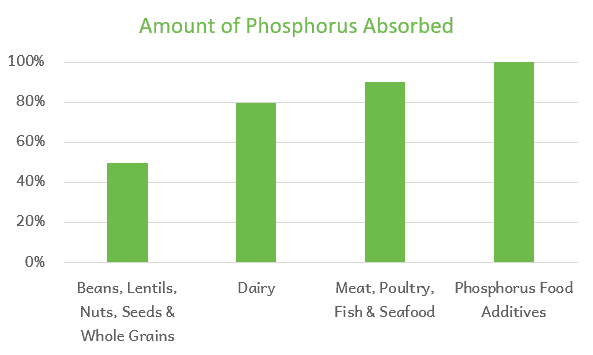
The difference in absorption can make a huge difference in how much phosphorus actually ends up in your body! For example, if someone ate 1000mg of phosphorus mostly from beans and whole grains, only 500mg would make it into our bodies. If that 1000mg of phosphorus was from fast food (which tends to be very high in artificial phosphorus), almost all 1000mg would make it in.
The lower availability of phosphorus in natural food sources, combined with the health benefits of foods naturally high in phosphorus, is leading to a shift in what a healthy low phosphorus diet looks like.
Finding Artificial Phosphorus
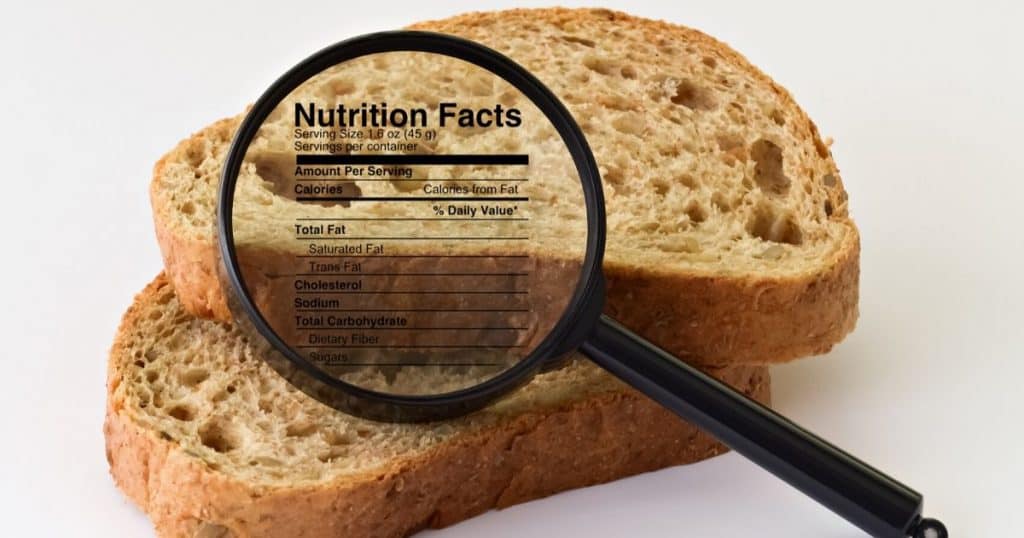
I use the term “artificial phosphorus” to refer to phosphorus found in food additives. Phosphorus is part of many chemicals that are added to our food for stability, taste, color, and preservation. (8) Phosphorus food additives are very common in the foods we eat. And, these have been added to our foods even more frequently in recent years.
Unfortunately, phosphorus is not explicitly listed on Nutrition Labels for most products in the United States. You are not able to simply read how much phosphorus is in a food by looking at the label, as you would for calories, sodium or fiber.
Instead, the best way to figure out if a product has a phosphorus food additive in it is to read the ingredients, usually located at the bottom of the Nutrition Facts label. Look for any ingredient that has the letters “PHOS” in it. You want to avoid products that have “PHOS” in any part of the word.
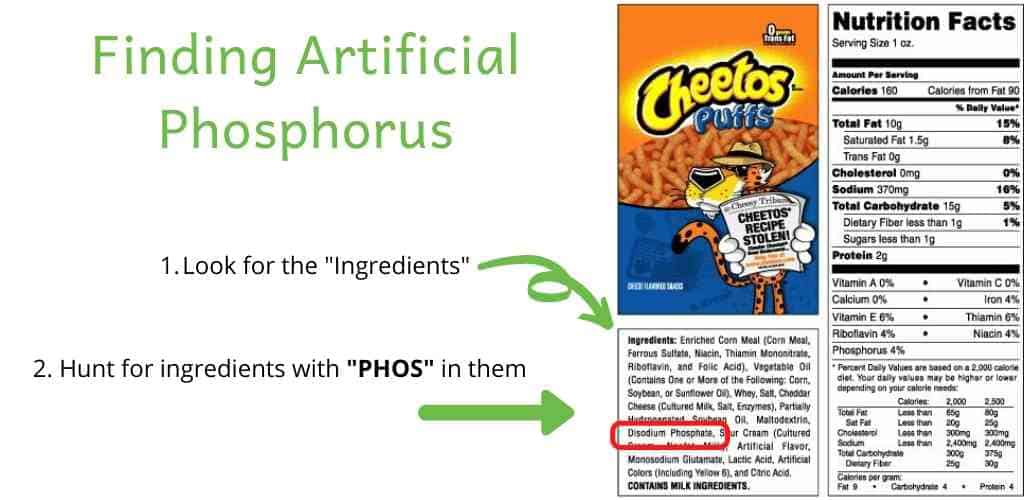
Some of the most common food additives that contain phosphorus: (9)
- Dicalcium phosphate
- Disodium phosphate
- Monosodium phosphate
- Phosphoric acid
- Sodium hexameta-phosphate
- Trisodium tripolyphoshate
- Tetrasodium pyrophosphate
I recommend checking every food label you come across for “PHOS” ingredients. You never know what kinds of foods phosphorus sneaks into!
There are types of food products that those “PHOS” ingredients are commonly found in:
- Ultra processed meats (lunch/deli meat, hot dogs, sausages, bacon, ham, corned beef, etc.)
- Ultra processed cheeses (American cheese, Velveeta, nacho cheese sauce, etc.)
- Cola (both regular and diet)
- Frozen or refrigerated prepackaged foods (think chicken nuggets, French fries, frozen dinners, rolls, pies, appetizers, etc.)
- Snack mixes (cheese puffs, chips, pub mix, etc.)
- Shelf stable prepared foods (box macaroni and cheese, canned stew or baked beans, pasta or rice with sauce, instant mashed or flavored potatoes, etc.)
- Sauces & Condiments (salad dressing, commercial marinades, jarred gravy or sauce, etc.)
- Commercial desserts (commercially produced cookies, cakes, pies, etc.)
The Old Low Phosphorus Diet
The traditional low phosphorus diet restricts both natural and artificial sources of phosphorus. Natural sources of phosphorus include whole grains, nuts, seeds, legumes, dairy and chocolate.
We now know that many of these foods are actually good for kidney disease. Plant proteins like beans, lentils, nuts and whole grains have actually been shown to slow the progression of kidney disease. They are also good for health conditions common in people with kidney disease such as acidosis, diabetes, and heart disease.
The New Low Phosphorus Diet
The new low phosphorus diet primarily focuses on avoiding artificial phosphorus. Artificial phosphorus is where most of the phosphorus in our diet comes from. In most people, simply avoiding artificial phosphorus results in healthy phosphorus levels. This allows people with kidney disease to enjoy many more healthy, delicious foods!
Natural sources of phosphorus like nuts, beans, lentils, seeds, and whole grains are actually encouraged on the new low phosphorus diet!
Meat & Eggs in the Low Phosphorus Diet
Meat and other animal proteins like poultry, fish and seafood have significant amounts of phosphorus. If avoiding artificial phosphorus is not enough to bring phosphorus levels to normal, this is the next place to tackle.
CKD Stages 1-5 (without dialysis)
People who have CKD who are not on dialysis should limit how much protein they eat. This is because high protein diets can make kidney disease progress faster. (10) The National Kidney Foundation recommends limiting protein to 0.6-0.8 grams per kilogram body weight per day. (5)
Because of their high protein and phosphorus content, meat, chicken, turkey, fish, seafood, and eggs should be eaten in smaller portions. Healthy portion sizes of meat are different for everyone. For most people, aiming for no more than 3-6 ounces of meat per meal is a good goal. Or, think about a portion ½ the size of the palm of your hand. For eggs, aim for 1-2 per meal.
End Stage Renal Disease (people on dialysis)
For people who are on dialysis, protein needs are much higher. The National Kidney Foundation recommends up to 1.2 grams of protein per kilogram body weight. (5) Work with your dietitian to figure out what meat portion size is best for you!
Dairy in the Low Phosphorus Diet
Cow’s milk, and therefore all dairy, also has quite a bit of phosphorus in it. For people with CKD stage 4-5 or who are on dialysis, it is a good practice to limit dairy to ½-1 cup per day. Of course, you should ask your dietitian what’s best for you.
Rice and almond milk are lower in phosphorus compared to cow’s milk and make excellent substitutes. But, be careful to avoid artificial phosphorus in the brand that you buy! Check out this great article about milk and kidney disease.
Bottom line: the healthy amount of meat and dairy will be different for everyone depending on your level of kidney function, body size and medical history. As always, work with your dietitian to figure out what is best for you!
Healthy Drinks in the Low Phosphorus Diet
Beverages can be a surprising source of phosphorus in our diets! Remember, artificial phosphorus is not limited to food!
You’ll find artificial phosphorus in cola (both regular and diet), some flavored waters, iced teas, and other commercial drinks.
Phosphorus is very different even for different flavors of the same brand of product. For example, Crystal Light Blackberry Lemonade does not have added phosphorus, but Crystal Light Raspberry Lemonade does. Note that almost all Crystal Light products have added potassium too!
Of course, the best drink for nearly everyone is old fashioned water. However, we all need to mix it up sometimes! Most unsweetened, flavored carbonated waters do not have artificial phosphorus. Or, even having an occasional diet clear soda such as Sprite or 7-Up is okay as well. Make your own iced tea or lemonade at home to avoid artificial phosphorus. Try infusing your water with fruits or herbs (strawberry basil is my favorite!).
Low Phosphorus Foods
How do we put all this information together? Here is a list of low phosphorus foods I recommend for a low phosphorus diet. This information is also available as a Low Phosphorus Diet PDF.
| Foods Recommended on a Low Phosphorus Diet | Foods NOT Recommended on a Low Phosphorus Diet | |
|---|---|---|
| Proteins | 3-4oz portions fresh or frozen meat, turkey, fish & seafood | Processed meat (deli meat, bacon, sausage, hot dogs, corned beef, salami) |
| 1/2 cup portion beans, lentils, legumes or tofu | Breaded or fried meats | |
| 1-2 tablespoons nut butter | Organ meats (liver, kidney) | |
| 1-2 eggs | Meat, fish and chicken from fast food restaurants | |
| Rice milk | Large amounts of cow’s milk | |
| Dairy | Almond milk | Processed cheese like Velveeta®, American or Cheez-Whiz® |
| Natural cheeses like mozzarella, Swiss, goat or cheddar | Milk substitutes with phosphate additives | |
| Grains | Whole Wheat Bread & Pasta | |
| Brown Rice | Grain products with artificial phosphorus. Look out for: | |
| Oatmeal, cream of wheat & grits | Flavored rice/pasta mixes | |
| Whole grain cold cereals (bran flakes, cheerios, wheat Chex®) | Bread/cake/muffin/pancake mixes | |
| Macaroni & Cheese | ||
| Commercially made cornbread, muffins and other baked goods | ||
| Fruits & Vegetables | All fruits & vegetables are naturally low in phosphorus! | Breaded or fried vegetables |
| Vegetables with creamy sauces | ||
| The exception is beans, lentils and legumes. Check out recommendations for these in “proteins” | Vegetables or fruits in frozen/canned prepared food | |
| Dried fruit with added phosphorus | ||
| Desserts | Sherbet or sorbet | Ice cream or pudding |
| Fruit crisp or pie | Commercially made cakes, cookies, pies with artificial phosphorus | |
| Homemade cookies or cake | ||
| Fruit | ||
| Drinks | Water! | Cola |
| Clear soda | Drinks with artificial phosphorus | |
| Homemade unsweetened iced tea |
Low Phosphorus Diet Final Thoughts
For most people, learning about the new low phosphorus diet is refreshing! If you focus on limiting artificial phosphorus, there is plenty of room for healthy foods like beans, nuts and lentils.
This is great news because we know that plant proteins are associated with slower progression of kidney disease. (10) Also, perhaps most importantly, the new low phosphorus diet is less restrictive. A less restrictive diet helps people enjoy food (and life!) and helps people stick with a healthy eating plan. This is great news for everyone.
Happy Eating!
Melanie

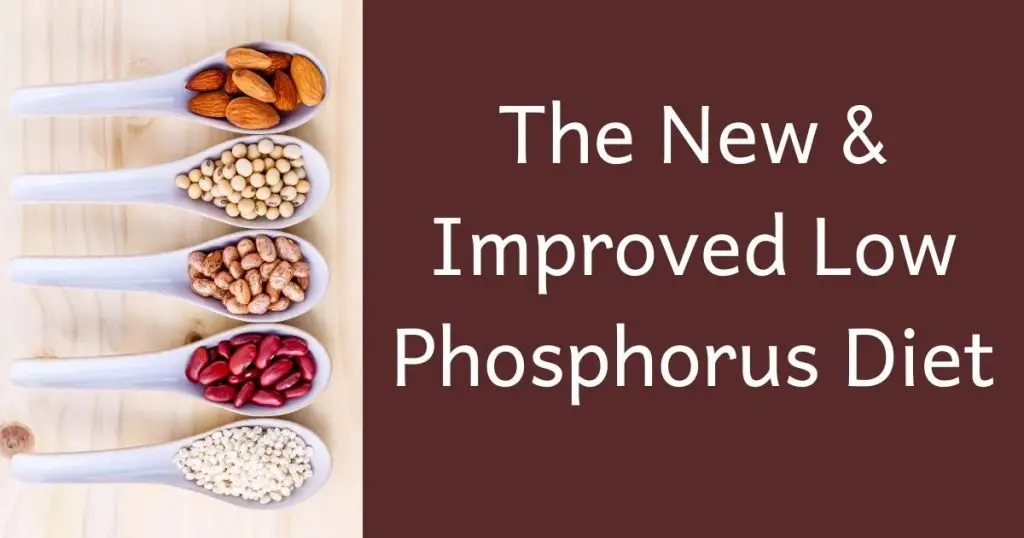
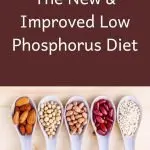
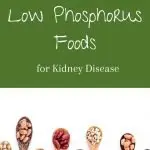
I have Kidney disease Stage 3 and Pre-Diabetes. I also have High Blood Pressure under control and High Cholesterol under control both with daily medication. All four illnesses appear to have different diets. How can I get help to co-ordinate one food plan considering all four medical issues?
Hello! It can definitely feel overwhelming trying to combine recommendations for multiple health conditions. I’d say that a healthy diet for all of these is actually MUCH more similar than you might think! This post about a diabetic renal diet will be helpful. Ultimately, I’d recommend meeting with a renal dietitian to help you understand what makes the most sense for your specific situation!
I am so confused as every kidney organization on internet has their own spiel on what is safe to eat and what to avoid for those with CKD…all of them say to avoid beans, lentils, nuts, eggs and whole grains if one is on a low protein, low, phos, low potasium and low sodium diet. Your article states we can now enjoy all these so called banned foods. Is this for real?? If so, does one have to use the dried form of beans and pulses? Or is rinsing canned beans good enough?
Hi Ann! I agree there is (unfortunately!) so much conflicting info out there. I think this is partially from a HUGE shift in how we think about kidney friendly eating recently – there were huge changes in the updated nutrition guidelines that came out in 2020. It takes awhile (likely years!) for websites, written info and doctors/dietitians to catch up. In addition, there is NO single “kidney diet” and food patterns that are best for you are 100% dependent on your stage of CKD, labs and other medical history. I think this also adds to the confusion for people when you try to Google what a “kidney diet” is. Here is an article I wrote as an overview for how a kidney diet is different for everyone! Because of this, I can’t say what is best for you in terms of the canned vs. rinsing canned beans.
Hi Kathy! It is very difficult for me to guide you without knowing about your medical history, labs and stage of CKD. There is no “kidney diet” that is right for everyone. I’d definitely recommend asking for a referral to see a dietitian to help you put all the pieces together! Your doctor may have someone they recommend. I also have a list of dietitians who work with patients. Hope that helps!
Hi. Just saw your site. I am a 3rd stage CKD person with a declining GFR. I was told by the doc. that my kidney’s were getting worse. I had a limited consultation with a dietician. Am trying to maneuver through a diet plan. The problem is I am also on warfarin for lifetime. Need help with a diet plan/recipes. If you have any recipes for kidney/warfarin or could direct me to a site I would appreciate. Please respond via email so that I will be sure to receive your rely. Thank you for your help.
Hello! Thank you for your message. I don’t have any recipes specific to warfarin and CKD. A healthy diet for kidneys is VERY individual to each person – learn more here! I’d suggest seeing if you can work with another dietitian – or that same one again – to learn more about what is best for you!
I would love nothing more than to down some good 100% grass fed organic beef bone broth, but I read the study that says it actually progresses kidney disease faster to end stage renal failure. Are there any good scientific studies you know of, that have recently countered that claim? Thanks! 🙂
Hi Donnelly! I’m not aware of any studies specifically looking at bone broth and CKD. In general, I’d be very wary of the amount of sodium in most bone broths (and, all broth for that matter!). Likely, if you can fit some of that broth in your daily sodium limit, it would be okay. But, I’d ask your dietitian what is best for you!
Diane @[email protected]
Dear Melanie, you are a Godsend. Besides you I just finally got a dietitian to call me back. I have stage 3 KD and Gastroparesis. Almost impossible making these two diets work together. There is only ONE known Renal Dietician in our area and she only works with transplant patients. Other dietitians only work with Diabetics who get gastroparesis. I am not a Diabetic. But KD makes it worse. Thank heaven for the information you have given me. It helps. Bless you. Diane St. Claire Shores Michigan. July 7,2021.
Hi Diane! Thank you for your comment! I’m SO glad you’ve found my site helpful. And VERY happy that you’ve found a renal dietitian.
P.S: My grandparents had a cottage on Harsen’s Island until a few years ago. MANY wonderful memories on the water on Lake St. Claire!
Melanie, I’m not sure how I got here, but I am thanking the Lord I did. In the past 8 months my husband has been diagnosed with two different kinds of cancer, one in the colon and one in the kidney, plus he is going through chemo and lactose intolerant. They just removed one kidney. That adds up to 4 different eating needs. The kidney has been the hardest with all the restrictions on (low) sodium, potassium and phosphorus, there is very little information, plus I’m not sure what his requirements are yet. The knowledge within your pages are a blessing. I now have a direction and an understanding in which to work with, until we get the answers we need. I cannot thank you enough.
Thank you so much for your comment Nancy! I’m so glad to hear my site has been helpful to you. This overview article about a “kidney diet” might be especially useful to you. Best wishes to you and your husband!
Dear Melanie, could you recommend a good cookbook for CKD one with nutritional list with every recipe? I am overwhelmed looking everything up? We eat a lot of veggies fruit and legumes and chicken and fish but I need to know the mg of the pottasium, phosphorus and sodium in the recipes. Thank you Chris PS do you have a cookbook, I didn’t think to ask that?
Hi Chris,
Yes! I have a few cookbook recipes on my resources page that I recommend. I actually collaborated with Dr. Shusterman for the Cooking Doc’s book if you want to check that one out! I also provide that information for all of the recipes on my recipe page as well. Hope that helps!
Kidney-friendly meals are sometimes posted as Low-Sodium, Low-Potassium, or Low-Phosphorous. I’m trying to figure out what low indicates. Is there a maximum mg for a meal to be considered Low-Phosphorous or Low-Potassium? Do Low-Phosphorous foods fall under a certain mg? Same question but for Potassium. Thank you for your help in this. Reva
Unfortunately, there is not a standardized “amount” for what is low or high for these nutrients. Sometimes, less than 140mg/serving is considered a “low sodium food”. Potassium and phosphorus are more difficult because the amount you can/should eat is based on your stage of CKD and lab values. I recently put this post together to try to help figure out what is important for you!
Melanie, I wrote to you above, January 4, 2021, about my husband. Today, we saw his doctor, and his GFR has dropped to 10. We need to lower his phosphorus to help stave off dialysis. Three days a week, he and his twin brother enjoy going to Whataburger for a biscuit with sausage gravy. I cannot find the amount of phosphorus in that. Can you give me an idea? How much of it would be absorbed? I appreciate any help you can give me.
Thank you so much,
Mary Jane Plemons
Hi Mary Jane. I’m sorry to hear about your husband. Do know that GFR fluctuates a few ml/min each direction every day. Although it seems scary, a change from 11 to 10ml/min is not a meaningful change in most cases. Phosphorus is tricky as it would be nearly impossible to know how much phosphorus is in foods. A will say that a sausage gravy biscuit from a fast food restaurant is going to be very high in phosphorus, and nearly all of it will be absorbed as most of the phosphorus is likely from additives and meat. However, don’t stress about what has already been eaten! Focus on limiting processed foods like that now and eating primarily fresh fruits, vegetables and whole grains!
My 14-year old Shih-Tzu girl was diagnosed with deteriorating kidney function. Can you direct me to where I can learn some more of the difference between human and canine renal diets. I fed her all my life with balanced raw beef meat food with once a week cottage cheese or canned mackerel fish and now I have to know exactly how much of it I can give her daily?
Thank you.
Hi Sonja! Thank you for your comment! I honestly have no idea where you might find information about renal diets for dogs. I would think your vet would be the best place to start!?
https://pubmed.ncbi.nlm.nih.gov/30322788/
J Ren Nutr. 2019 Mar;29(2):118-125.
doi: 10.1053/j.jrn.2018.08.001. Epub 2018 Oct 12.
Hi. Thank you for writing this. I just read about soaking lentils (and other beans) in water for 12 hours (refrigerated) and discarding the water because it leaches the Phosphorus and Potassium out. Similarly, bring potatoes to a boil. Stop and discard the water, then boil the potatoes until soft.
What do you think?
Barry
Hi Barry! Thank you for your comment. Yes, boiling any food will reduce the potassium content. Most studies have shown that boiling reduces potassium by about 50%. So, if your potassium levels are high, boiling foods like lentils is a great option! Of course, always check with your renal dietitian to know what is best for you. Phosphorus isn’t impacted by cooking methods as much – however remember that the phosphorus in lentils (and beans, whole grains, etc) is only about 20% absorbed anyway! So, generally we aren’t as concerned about the phosphorus content in lentils. Great article share!
Thank you so much. I spend a great deal of time planning and cooking for my husband, who is at Stage 5 with a GFR of 11. We have been dealing with his CKD for about 17 years, when he was diagnosed and was at Stage 3. He will be 83 in a couple of weeks, and he continues to feel and do really well. I have learned to pretty well manage his dietary limits and still serve mostly the same foods he has always liked. I firmly believe he can have “almost” anything, as long as it averages within his dietary limits over a three or four day period. His GFR has been below 15 for a few years. We’ve gotten his potassium levels back to the normal range, but the phosphorus was rising a little at his most recent labs, so this info is most welcome. Thanks again!
You are so welcome! I hope hunting for those phosphorus additives helps get that phosphorus level down!
I love Hills Bros sugar free cappuccino mixes. Other than that I follow my renal plan to the letter. I would change to regular instead of no sugar if that would help. I am stage 3a. I improved from 3b by following my plan and discontinuing some meds. Thank you so much.
Hi Mary
Sorry to hear about your husband’s challenges regarding his GFR
You mentioned his GFR being below 15 for 17yrs. Could you kindly share the secrets of how he managed this through diet?
How you (as a team no doubt) kept the potassium levels low/normal. I am really struggling helping a loved one whose kidney function has dropped suddenly.
Your help will be greatly appreciated. Raz
GREAT info. I have 2 questions. If I run the contents of a can of beans, lentils, tuna fish or salmon under cold running water, will that help to reduce the amount of sodium, phosphate and phosphorus?
Also, what actually is the acme amount of sodium, phosphate and phosphorus I should eat in a day?
Hi Janet. Thank you so much! Running canned food under water will help reduce sodium. Probably not the potassium or phosphorus as much. The right amounts of each of those nutrients is different for everyone. It is based on your lab results and stage of CKD. A good sodium goal for nearly everyone is 2,300 mg/day. Potassium and phosphorus is much more individualized. I would ask your doctor or dietitian what is best for you!
Thanks lots of useful info
Thank you, Ellen!
Thank you. My nephrologist told me to cut back on salt and animal protein, but this article gave me so much more direction.
Thank you so much for your comment, Carol! I’m very happy to hear this info was helpful. Reducing salt and animal protein is important – but not the whole story! Please let me know if you have any other questions.
Good you pointed out about the restrictions on protein. My diet is restricted on protein, so I can modify my diet correctly.
Yes! If you have kidney disease and are not on dialysis, it is recommended to be on a low (or moderate) protein diet. This alone will MASSIVELY help with lowering phosphorus intake. Thanks for sharing!
Hi Melanie,
What is a person to do if they are diabetic as well and need a low carb diet to control blood sugars? Low carb and low protein doesn’t leave a lot left. Lol!
Hi Mary Ellen! Thank you for your comment! Many times, the protein restriction isn’t quite as low for people with diabetes to help control blood glucose. Plus, give you something to eat (as you alluded to!). I’d ask your dietitian what is best for you!
Wow!! thank you so much, Melanie.
You are so welcome!
Hi, Wow!! I learned alot. I would love to know how i can keep this information handy. I eat alot of veggies and fruits. Good know about lentils. One of my favorites. Thank you so much. Thank you,Constance Hampton
Hi Constance! Thank you so much! I am so excited to hear that you learned more about a healthy kidney diet – and that you feel more comfortable eating lentils now! This post will be up for you to reference anytime!